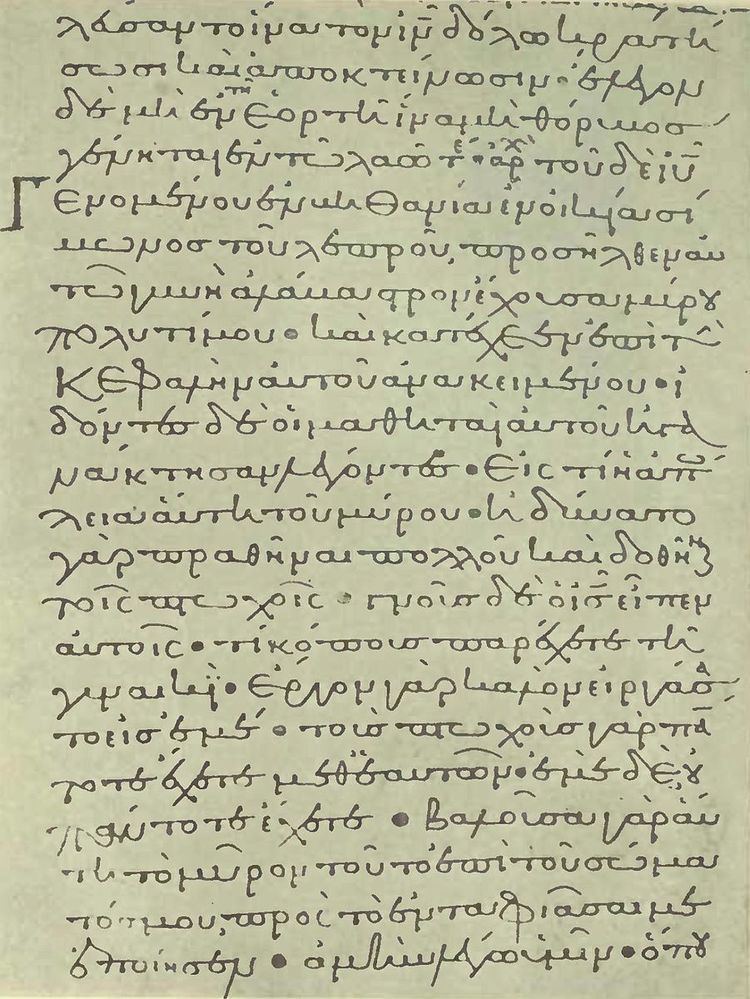Date 1122 | Size 18.6 cm by 13.6 cm | |
 | ||
Minuscule 157 (in the Gregory-Aland numbering), ε 207 (Soden), is a Greek minuscule manuscript of the New Testament, on vellum. According to the colophon it is dated to the year 1122. Formerly date was wrongly deciphered as 1128? (Gregory, Thompson). It has complex contents and full marginalia.
Contents
Description
The codex contains a complete text of the four Gospels on 325 parchment leaves (size 18.6 cm by 13.6 cm). The text is written in one column per page, in 22 lines per page.
The text is divided according to the κεφαλαια (chapters), whose tables are given before each Gospel (tables of contents), numbers at the margin of the text, and their τιτλοι (titles of chapters) at the top of the pages. There is no a division according to the Eusebian Canons though the Eusebian Canon tables are placed at the beginning.
It contains the Epistula ad Carpianum, prolegomena, lectionary equipment, subscriptions at the end of each Gospel, ornaments and pictures in vermilion and gold. The Gospel of John is preceded by portrait of John evangelist with Prochorus.
It has the famous Jerusalem Colophon ("copied and corrected from the ancient manuscripts of Jerusalem preserved on the Holy Mountain") at the end of each of the Gospel. It is very beautifully written.
Text
Although the manuscript was made for the Emperor its text is not the standard Byzantine but a mixture of text-types with strong the Alexandrian element. Its readings often agree with Codex Bezae, with some affinities to Diatessaron, and to Marcion's text of Luke (see Gospel of Marcion).
Hermann von Soden lists it as Is (along with codices 235, 245, 291, 713, 1012). Aland placed it in Category III.
According to the Claremont Profile Method it represents Kx in Luke 1; in Luke 10 it is mixed with some relationship to the Alexandrian text; in Luke 20 it has the Alexandrian text.
In Matthew 6:13 it has unusual ending of the Lord's Prayer:
ὅτι σοῦ ἐστιν ἡ βασιλεία καὶ ἡ δύναμις καὶ ἡ δόξα, τοῦ πατρὸς καὶ τοῦ υἱοῦ καὶ τοῦ ἁγίου πνεύματος εἰς τοὺς αἰῶνας. ἀμήν (For thine is the kingdom and the power and the glory, of the Father and of the Son and of the Holy Spirit for ever. Amen.)
This ending have only two other manuscripts: 225 and 418.
In Matthew 13:15 it reads: Ἰωσῆ (Joses), the reading is supported by the manuscripts: 118 700* 1071 syrh cobomss
It does not include texts of Matthew 16:2b–3 and Pericope Adulterae (John 7:53-8:11).
History
It was written in 1122 for John Porphyrogenitus (1118-1143). The manuscript belonged to the Ducal Library at Urbino, and was brought to the Rome by Pope Clement VII (1523-1534).
In 1788 Andreas Birch made a facsimile. According to Birch it is the most important manuscript of the New Testament, except Codex Vaticanus. It was examined by Scholz, collated by Hoskier. C. R. Gregory saw it in 1886. Scrivener noted that this codex is often in agreement with codices: Vaticanus, Bezae, Regius, 69, 106, and especially with 1.
It is currently housed at the Vatican Library (Urbinas gr. 2), at Rome.
